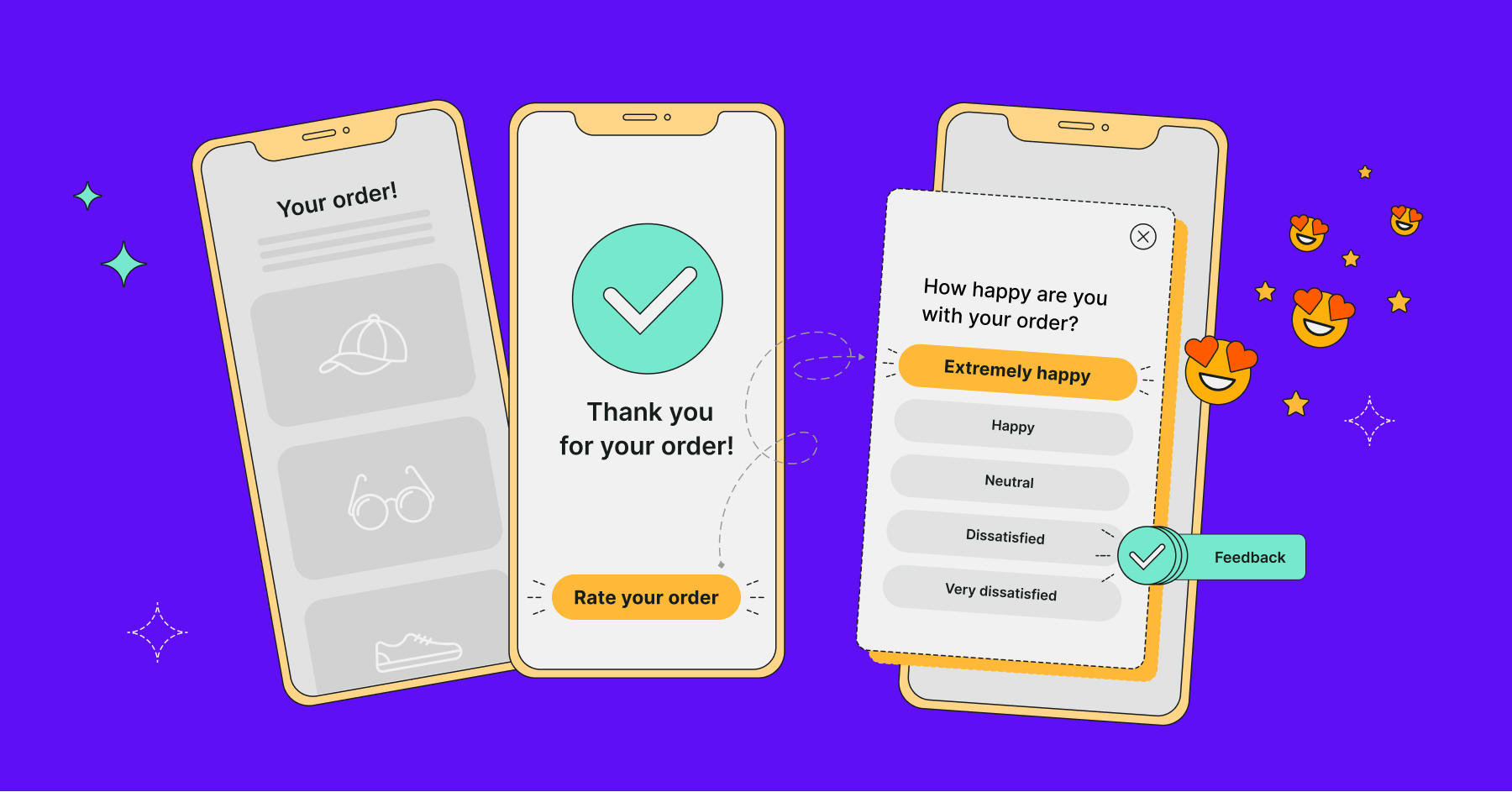Imagine you want to know how many people in the US drink coffee every morning. If you ask 10 people, that likely isn’t representative of such a large group.
But if you want to know how many of your 50 coworkers do so, 10 respondents may be enough to get the right idea.
That is what a survey sample size is in a nutshell. It’s not usually possible to collect feedback from an entire group you are trying to survey. So you have to decide how many people you need answers from to get reliable results.

What is Survey Sample Size?
A survey sample size is the number of participants in a study. In other words, the number of people who responded to your survey.
When conducting any survey, one of your main goals is to get results that are statistically significant. This means enough responses to infer conclusions with confidence.
Sample size usually refers to surveying large populations. So, if all you want to do is find out your 500 customers’ satisfaction, you likely won’t have trouble getting a representative sample.
On the other hand, if you want to see how many marketers in the US are potential customers for you, you’ll have to make do with a statistically significant portion of them.
PS: Check out this persona survey template to figure out where to look for potential customers!
What is a Good Sample Size for a Survey?
When the sample size is too small, you may get a disproportionately small or large number of outliers. This can skew results significantly.
On the other hand, while surveying more people will always get you more accurate results, it is often unfeasible, complex, and expensive. Oftentimes, surveying the entire population is not worth the time and effort.
So, what’s the golden mean?
Many statisticians concur that a sample size of 100 is the minimum you need for meaningful results. If your population is smaller than that, you should aim to survey all of the members.
The same source states that the maximum number of respondents should be 10% of your population, but it should not exceed 1000.
For instance, if you have a population of 250,000, 10% would be 25,000. Since this is higher than 1,000, a sample size of 1,000 should be enough to get you statistically significant results.
How to Determine Sample Size for a Survey
Calculating sample size can be made easier with software such as a calculator. Still, let’s have a look at what the process is like behind the scenes.
Sample Size Formula
The survey sample size is usually determined with a take on Slovin’s formula.
.png)
Here is what you’ll need.
“P”, which is your standard deviation
This is how confident you can be that a population will select an answer within a given range. In plain English, this would be how extreme you can expect the responses to be.
A low standard deviation means that you don’t expect your respondents to be extreme. A higher standard deviation will mean that you expect respondents to choose answers from the ends of the spectrum.
Standard deviation is given as a number between 0 and 1. If you are unsure, go with 0.5, which is the exact midway point. Bear in mind, though, that this might make your results more estimated.
“Z”, which represents your “z score”
Your z score is the number of standard deviations a given group is away from the mean.
Thankfully, you can use a cheat sheet to determine your “z score”, depending on how confident you want to be about your results.
For example
- 99% desired confidence level would equal a z score of 2.58
- 95% would equal 1.96
- 90% is 1.65
- 85% is 1.44
According to Lisa Sullivan, Professor of Biostatistics
“a 95% confidence interval means that if we were to take 100 different samples and compute a 95% confidence interval for each sample, then approximately 95 of the 100 confidence intervals will contain the true mean value”.
In layman’s terms, if you calculate your sample size with a z score of 1.96, then if you were to repeat your survey 100 times, you would get the same mean result about 95 times.
“E”, which is your margin of error
The margin of error is basically how sure you need to be that the results are accurate for the entire population. The bigger the margin of error, the less reliable your results are.
You usually want the margin of error at around 5% or less. This means you can be 95% or more sure that your results are accurate.
For example, let’s say you discover that 85% of your respondents find your customer service effective. If you assumed a 5% margin of error, you must add 5% to either side of the score.
In essence, you can assume that 80-90% of your customer base is satisfied with your customer service.
The margin of error should be provided in decimal form. Note that the smaller margin of error you want, the larger your sample size will be.
And finally, “N”, which is your population size
The population is all the people whose attitudes or stances you are trying to learn about.
The population could be anything from all of your customers to all people on Earth. The bigger your population, the bigger your sample will need to be in order to get reliable results.
When you know what your population is, you need to figure out how many people are in that category.
For instance, if you wanted to get accurate survey results for the entire US, your population size would be 329.5 million (source: World Bank, 2020).
If you wanted to run an NPS campaign, you’d consider all of your existing customers.
Calculation: What Sample Size is Needed for a Survey?
Determining the sample size begins with considering the population in a study.
So, let’s say I wanted to survey a population of 500, and I want to be 5% confident that I will get accurate results 95% of the time. I would need to survey 218 people.
This formula may seem confusing. You can use this spreadsheet I prepared to skip the manual labor. Make sure to copy the spreadsheet and edit only the green fields.
Let’s work with another example. We’ll assume the following values:
- 95% confidence level
- 0.5 standard deviation
- 5% margin of error
- Population of 10,000
Using our spreadsheet, you can see that you should survey at least 370 people. And Survicate is currently working on a sample size calculator, so stay tuned!
Once you have your sample size, you have to account for your response rate. You can expect it to be more or less 20-30%. If you expect to get fewer responses, send the survey to a larger number of people to reach your sample size milestone.
How to Decide Who to Include in Your Sample?
For small to medium-size businesses, the method of getting a sample is usually to send the survey to the entire customer base and hope to get enough responses.
But you may want to target your survey as well. For example, if your previous survey showed you have relatively few NPS detractors, you may want to target them specifically to find out whether their score had changed or to get more details.
Nonetheless, choosing a random sample will usually get you the most reliable results for your population.
What if You Can’t Get Enough Responses?
Sometimes, you just can’t get the number of responses to match that magical sample size you desire. Using great survey tools may help boost your response rate, but what if you still can’t get close to 100?
Calculating sample size in survey research is still important. You can benchmark how many more responses you need and thus, how you can treat incomplete results.
While your results may not be statistically significant, you can still use the feedback to fuel your business decisions. The answers will still be valuable, especially if you make good use of open-ended questions for context.

Send surveys through any channel with Survicate
Generally speaking, most surveyors want the results to be as comprehensive as possible. The more responses you get, the better. The only limiting factors are time and money.
With survey software like Survicate, you can target your audience directly through your website, email, or app, without having to manually reach out or ask bystanders. This cuts down on the required time and effort considerably.
Simply use one of our ready-to-send templates and start gathering feedback. Now, you can take advantage of our 10-day free trial to test all Business plan features with up to 25 survey responses.

.webp)






.svg)
.svg)
.svg)

.svg)


.svg)







.svg)




.svg)

















.svg)






























.svg)

.svg)
.svg)

.svg)



.svg)





.png)

.svg)

.svg)




.png)
.jpg)



